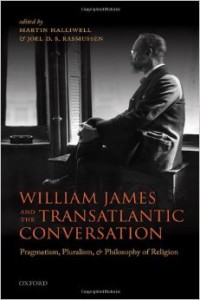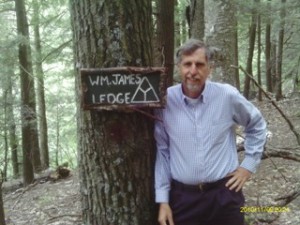Martin Halliwell and Joel Rasmussen, eds., William James and the Transatlantic Conversation: Pragmatism, Pluralism, and Philosophy of Religion (New York: Oxford University Press, 2014) 256 pages.
Review by Paul Croce
There is a specter haunting this lively and insightful anthology, the specter of ambivalence. William James and the Transatlantic Conversation presents essays by leading scholars depicting James not only between North America and Europe, but also between an abundant variety of contrasts, mostly dealing with the topics named in the subtitle, Pragmatism, Pluralism, and Philosophy of Religion: James between Victorianism and modernism, psychology and philosophy, theory and poetry, embodied and abstract consciousness, agnosticism and theism, and more.
Attention to James’s range of coverage and ambivalence harks back to his reputation during his lifetime and for the first half-century after his death in 1910: in an era turning toward intellectual specialization and science-inspired philosophy, James’s diversity signaled lack of seriousness, with his accessible style and popularity seemed to confirm his lack of rigor. This avuncular reputation has persisted in Charles Taylor’s identification of James as the “philosopher of the cusp,” ranging over competing positions but never fully committing, and Richard Gale’s patronizing depiction of The Divided Self of William James.
In this volume, Richard King shows a characteristic impatience with James’s “unwillingness to commit” (53) on religious issues, even as he also acknowledges James’s acceptance of different “over-beliefs,” since “we need them … all (59). This combination shows the steps that these essays take toward reframing the reputation of James the ambivalent, from label for his philosophical or temperamental 
weakness to indicator of his intellectual vision and strength.
This volume also offers essays explaining the significance of James’s pluralistic metaphysics of radical empiricism, with its attention to the reality of relations, the prevalence of genuine novelty, and the significance of each-forms pointing to the importance of uncountably plural parts of the world and interpretations about it. This metaphysics suggests that a keynote for James was his awareness of the robustly diverse complexity of reality, especially by comparison with the “shiveringly thin wrappings” of our conceptions (152).[ii] Many of his ambivalences, therefore, were not so much products of indecision, but of his unblinking recognition of actual abundance in experience, allowing for many different possible characterizations, suggesting the limits of our theories even as their insights offered potential usefulness.
The comprehensiveness of James’s reach is an outlook suited to our times. David Hollinger points out James’s pioneering role not only in mediating science and religion, but also in speaking to demographic diversity; and in an essay synthesizing the whole volume, Jeremy Carrette shows the decisive impact of James’s upbringing and career across cultures, and his internalization of that “zig-zag” life in his pluralistic understanding of “consciousness-as-relation” (212).
 An anthology of essays by twelve creative minds from a variety of disciplines offers a platform well suited to its message about the range of James. Approach and message combine to add force to the volume’s ability to unsettle assumptions, often about James’s reputed ambiguities. In light of this, it was surprising to find a warning in the editors’ “Introduction” to avoid the “temptation to push a mercurial figure such as William James into too radical a mold” (60).
An anthology of essays by twelve creative minds from a variety of disciplines offers a platform well suited to its message about the range of James. Approach and message combine to add force to the volume’s ability to unsettle assumptions, often about James’s reputed ambiguities. In light of this, it was surprising to find a warning in the editors’ “Introduction” to avoid the “temptation to push a mercurial figure such as William James into too radical a mold” (60).
The early essays depict James assembling insights from his contexts and experiences. Jaime Nubiola sets the tone with a panoramic tour of James’s encounter with Europe; and Peter Kuryla finds philosophical influence in the prosthetic leg of James’s father for the son’s “interest in morbidity, mediums, and religious mysticism” (81). In James’s deep aesthetic reflections, Barbara Loerzer explains his use of metaphors to capture “surplus of meaning” (70), which he would use when explaining religious experiences, especially mysticism; Loerzer detects Catholic leanings in these surges of visuality that would also predispose him to a metaphysics of pluralistic particularity.
Leslie Butler contextualizes James’s ambivalence about women’s equality through his youthful assessment of liberal John Stuart Mill and conservative Horace Bushnell. James’s own married life enacted more of Bushnell’s assumptions, but James showed more admiration for Mill, even as he recognized a fruitful tension: Mill presented marriage as a friendship of equals, while James maintained that married mates supply deep emotional needs not just equal partnership (124). However, James mediated the liberal-conservative polarity in his use of the mental tools usually associated with conservatism (the appeal of sentiments, the significance of religion) to achieve some of the ends of liberalism (overcoming human blindness, emphasizing free will and usefulness); and he also anticipated the liberalism of difference feminism in his unprogressive view of unequal married relations since in the spirit of the woman’s conventional role, he actually “heartily approved … [of] emotional baggage” through the intellectual (127-28).
David Lamberth recognizes James’s ambivalence about philosophy, showing him at once defending his theoretical positions and also sympathizing with common sense approaches to philosophizing that include less exactitude and more emphasis on “philosophy-as-worldview” (135). This offers a prelude to Lamberth’s astute connections between James’s early recognition of diverse forms of rationality and his mature pluralistic metaphysics. Sami Pihlström shows James justifying religion in ethical terms. This emphasis on ethics in religion is a reminder of Lamberth’s hope for philosophical assessments of “better and worse” forms of religion; each commentator pays little attention to the views of most believers who heartily seek more than worldly and ethical justifications for their beliefs. James himself readily recognized the religious quest for other-worldly transcendence; his assessment of spirituality focused on the subliminal realm as a site for both this-worldly psychology and possible other-worldly contact. Even the uncertainty of such contact, which James readily admitted, offered potential for mediation because of his emphasis on mystery, with admission of human limitation in all our inquiries, including the religious.
Rasmussen depicts James between the absolute idealists of his day and the neo-pragmatists of our own. Respectively, they privilege philosophy and literary narratives, and Rasmussen elegantly summarizes their mirror-opposite similarity because they each offer totalizing perspectives: either “there is an all,” or “that’s all there is” (166), with James avoiding the finality of either orientation. In addition, Rasmussen’s focus highlights the absence of another absolute that also troubled James: scientific materialism. In fact, this whole volume offers little attention to James’s engagement with science, both his immersion in study of natural science, and with the partial exception of Hollinger, the centrality of the tension between science and religion throughout his work. In his in-depth analysis of James’s critique of absolute idealism, Michael Slater notes that James adopted the term “hypothesis” to describe religious belief, which like a scientific hypothesis involves tentative not dogmatic commitment; but Slater argues that James’s use of the term is not “properly scientific” because such religious belief “cannot be empirically tested” (175). This shows assumptions about science that James rejected in favor or viewing empiricism in experiential terms. James did not reject empiricism on the model of laboratory testing, but regarded it as one way to grasp experience, not the only way; and he applied his broadened empiricism to beliefs in general, including those of religion and science.
This volume, with its twelve laboratories of imaginative inquiry, pushes the boundaries for our understanding of James, with attention to the range of issues that he comprehended in relation despite their conventional contrasts. These essays make particularly striking contributions to the significance of James’s fluid circulation with theorists on both sides of the Atlantic, and to the synthesizing role significance of his Pluralistic Universe. James would not be surprised to find paths for still further exploration, especially in his respect for scientific inquiry and wariness about claims to scientific certainty, and in the penumbra of mystery that pervaded all his inquiries. In these ways, James himself followed his own temptations toward the radical implications in his thought.
[i] Taylor, Varieties of Religion Today: William James Revisited (Cambridge: Harvard University Press, 2002), 59; Gale, The Divided Self of William James (New York: Cambridge University Press, 1999). For Taylor, James’s ambivalence indicates his vague awareness of “something more, bigger outside you”; and for Gale, James’s writings convey an “absurd … quest to have it all” (270 and 272). For an overview of James’s changing reputation, see my “Reaching Beyond Uncle William: A Century of William James in Theory and in Life,” History of Psychology 13 (2010): 351-377.
[ii] Rasmussen quoting A Pluralistic Universe, ed. Frederick Burkhardt, et al., eds. (Cambridge: Harvard University Press, 1977), 64.
Paul Croce teaches American cultural and intellectual history at Stetson University. His prime research deals with science, religion, and William James. His books include Science and Religion in the Era of William James: Eclipse of Certainty (University of North  Carolina Press, 1995) and The Education of William James: Science, Religion, and Philosophy in Formation (forthcoming). He has been Chair of the Forum for History of Human Science and President of the William James Society. His new blog PubClassroom.com is designed to make scholarly insights more available for public discussion.
Carolina Press, 1995) and The Education of William James: Science, Religion, and Philosophy in Formation (forthcoming). He has been Chair of the Forum for History of Human Science and President of the William James Society. His new blog PubClassroom.com is designed to make scholarly insights more available for public discussion.

0